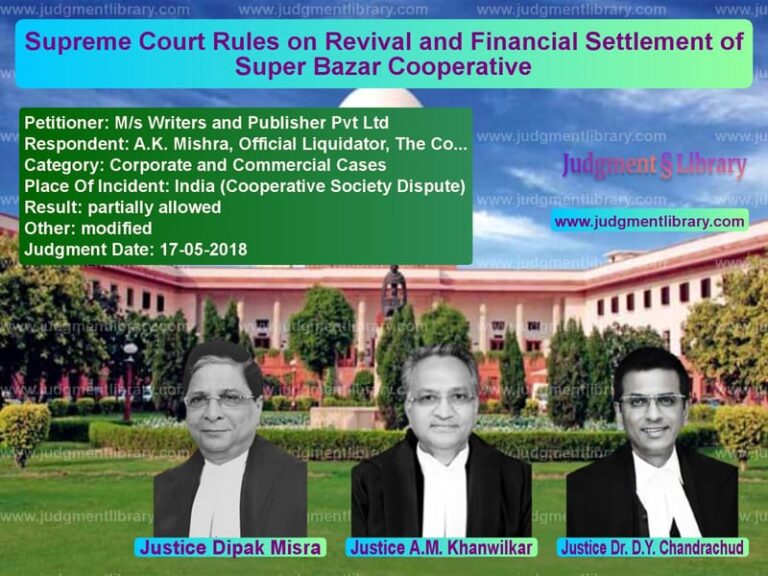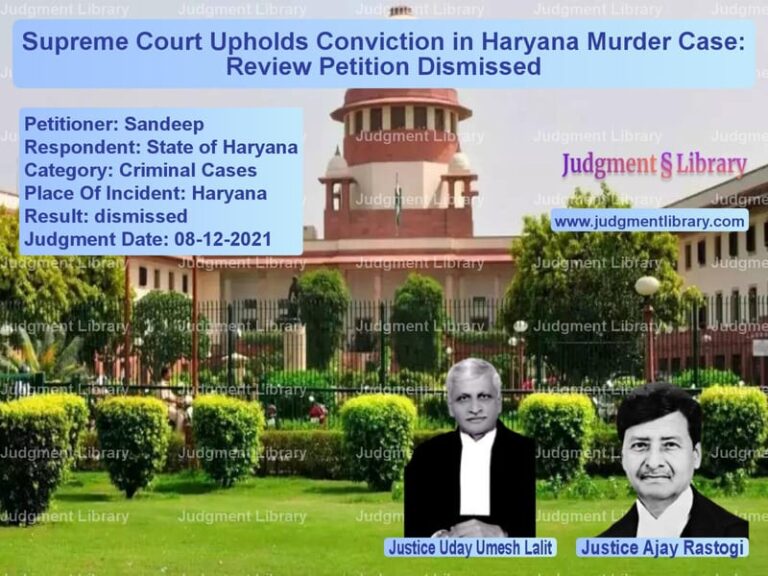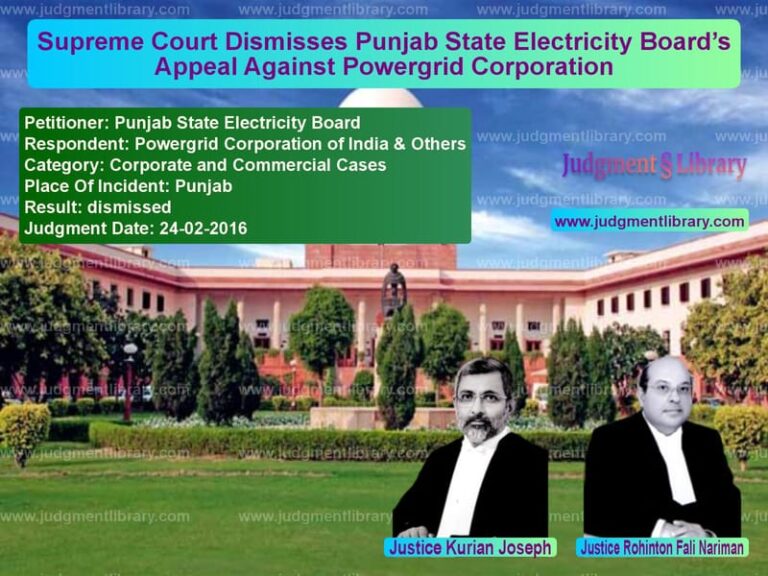Unlawful Assembly Murder Conviction: Supreme Court Upholds Vicarious Liability in Group Attack Case
In a significant criminal law judgment, the Supreme Court of India has upheld the convictions of three appellants in a brutal murder case, reinforcing the legal principle of vicarious liability under Section 149 of the Indian Penal Code. The case involved a coordinated group attack during wedding celebrations that resulted in one death and multiple serious injuries, testing the boundaries of criminal liability for members of unlawful assemblies.
The tragic incident unfolded during wedding ceremonies of the Gholap family in village Kari, Pune District, between April 25-27, 1999. The conflict began on April 26 when Ankush Gholap was assaulted during a wedding procession, leading him to file a police complaint that same night. The situation escalated dramatically the following day when Ankush, along with several companions, was returning from Bhor in a jeep driven by Sopan Dagadu Gholap (PW-1).
Near Navi Ali, their vehicle was intercepted by two motorcycles carrying six accused persons. According to eyewitness accounts, Haribhau @ Bhausaheb Dinkar Kharuse (accused no. 3/appellant no. 1) arrived on one motorcycle with Pandharinath Deoba Gholap (accused no. 1) and Maruti Ramchandra Gholap (accused no. 2) as pillion riders. Raju @ Rajendra Bhivrao Shirwale (accused no. 4/appellant no. 2) drove the second motorcycle with Vitthal Baburao Shinde (accused no. 5) and Subhash Raghunath Pawar (accused no. 6/appellant) as passengers.
The attack was swift and brutal. Appellant no. 1 removed the jeep’s keys and assaulted PW-1, while the other accused dragged Ankush and two other occupants from the vehicle. Accused no. 1 and 2 then attacked Ankush with sharp weapons, causing fatal injuries that resulted in his death on the spot. The other victims sustained serious injuries but survived the attack.
The legal journey through the courts saw dramatic shifts. The Sessions Court convicted accused no. 1, 2, and 6 but acquitted accused no. 3, 4, and 5 due to insufficient evidence. The High Court, however, partly allowed the State’s appeal and reversed the acquittal of accused no. 3 and 4 while confirming the convictions of the others. This led to the current appeals before the Supreme Court by the three appellants challenging their convictions.
The appellants raised several crucial legal arguments before the Supreme Court. Appellants no. 1 and 2 contended that “Ingredients of Section 149 of the IPC were not made out” and that “the High Court overstepped its jurisdiction by interfering with a plausible view of acquittal.” They argued that since accused no. 5 remained acquitted and there was no evidence against appellant no. 1, only four persons could be said to have participated, falling below the minimum threshold of five members required for an unlawful assembly under Section 141 of the IPC.
Their counsel placed reliance on precedents including “Daya Kishan v. State of Haryana, (2010) 5 SCC 81 and Naresh v. State of Haryana, (2023) 10 SCC 134, where this Court held that mere presence in an unlawful assembly without participation or intent cannot attract liability under Section 149 of the IPC.”
Appellant no. 6 advanced separate arguments, contending that “the evidence on record does not establish that appellant was a member of an unlawful assembly sharing a common object under Section 149 of the IPC to commit murder.” His counsel emphasized that “the prosecution itself admitted that appellant did not inflict any injury upon the deceased and the only allegation against him is of causing hurt to PW-7.”
The State, represented by the respondent, countered these arguments by emphasizing that “the conviction of the appellants was based on the consistent and credible ocular evidence of injured witnesses, duly corroborated by medical evidence and recoveries made at the instance of the accused persons.” They relied on the principle of vicarious liability under Section 149, arguing that “once it is established that an unlawful assembly existed and an offence was committed in pursuant of its common object, every member is equally culpable, irrespective of who inflicted the fatal act.”
The Supreme Court bench comprising Justices Prashant Kumar Mishra and Vipul M. Pancholi conducted a thorough examination of the evidence, particularly focusing on the eyewitness testimonies of PW-1, PW-7, and PW-9. The court noted that PW-1’s deposition clearly stated: “The accused persons removed weapons from the diccies of their motor-cycles. The accused No.2 Maruti was possessing Sattur, the accused No.1 Pandharinath and accused Nos.5 and 6 were possessing knives (Suri), accused Nos.3 Bhausaheb and accd. No.4 Rajendra were possessing the knives.”
The court found the testimonies to be “natural, coherent and mutually corroborative on all material particulars.” The judges emphasized that “PW-1 and PW-7 categorically stated that appellant no. 1 and 2 (accused no. 3 and 4) were among those who surrounded the deceased and the injured witnesses, thereby preventing their escape and were fully aware that the co-accused persons were armed.”
The medical evidence provided strong corroboration. The post-mortem examination conducted by PW-16 revealed that the deceased suffered multiple incised and penetrating wounds on vital organs, with death resulting from “haemorrhagic shock due to multiple injuries to vital organs like heart, liver, kidney, intestinal vessels and brain.” The injuries to the surviving victims were equally severe, with doctors testifying that they were sufficient to cause death in the ordinary course of nature.
On the crucial issue of common object and vicarious liability, the Supreme Court delivered a significant interpretation of Section 149 of the IPC. The court held: “Section 149 of the IPC unequivocally provides that every member of an unlawful assembly is guilty of an offence committed in prosecution of the common object or of one which such members knew to be likely committed in furtherance thereof.”
The court further elaborated: “In Masalti (supra) (para 17), this Court clarified that it is not necessary for each member of the unlawful assembly to have committed a specific overt act. Once participation and sharing of the common object are proved, every member becomes vicariously liable for offences committed in prosecution of that object.”
The judges rejected the appellants’ contention that there was no common object to commit murder, stating: “The nature of the weapons used, coupled with the ferocity and precision of the attack, unmistakably demonstrates that the common object of the assembly extended well beyond merely causing hurt and encompassed the commission of murder.”
The court emphasized the active role played by all appellants: “The cumulative evidence clearly shows that the appellants were not passive spectators but active participants and facilitators in a deliberate and planned assault. Their conduct and presence at the scene, in concert with the armed co-accused persons, establish their common intention and vicarious liability under Sections 302 and 307 read with Section 149 of the IPC.”
In its concluding remarks, the Supreme Court affirmed: “Upon a comprehensive appraisal of the entire record, this Court finds that the prosecution has proved beyond reasonable doubt that all three appellants were members of an unlawful assembly sharing the common object to commit murder and grievous assault.” The court dismissed all appeals, upholding the life imprisonment and other sentences imposed by the High Court.
This judgment serves as an important precedent in Indian criminal jurisprudence, clarifying that participation in an unlawful assembly extends beyond direct physical involvement to include facilitation, coordination, and shared criminal intent. The decision reinforces that when individuals join together with a common unlawful purpose, each member bears responsibility for the collective actions, ensuring that criminal liability reaches all participants in coordinated group crimes.
Petitioner Name: Haribhau @ Bhausaheb Dinkar Kharuse & Anr..Respondent Name: The State of Maharashtra.Judgment By: Justice Prashant Kumar Mishra, Justice Vipul M. Pancholi.Place Of Incident: Village Kari, Pune District.Judgment Date: 29-10-2025.Result: dismissed.
Don’t miss out on the full details! Download the complete judgment in PDF format below and gain valuable insights instantly!
Download Judgment: haribhau-@-bhausaheb-vs-the-state-of-maharas-supreme-court-of-india-judgment-dated-29-10-2025.pdf
Directly Download Judgment: Directly download this Judgment
See all petitions in Murder Cases
See all petitions in Attempt to Murder Cases
See all petitions in Bail and Anticipatory Bail
See all petitions in Extortion and Blackmail
See all petitions in Fraud and Forgery
See all petitions in Judgment by Prashant Kumar Mishra
See all petitions in Judgment by Vipul M. Pancholi
See all petitions in dismissed
See all petitions in supreme court of India judgments October 2025
See all petitions in 2025 judgments
See all posts in Criminal Cases Category
See all allowed petitions in Criminal Cases Category
See all Dismissed petitions in Criminal Cases Category
See all partially allowed petitions in Criminal Cases Category







